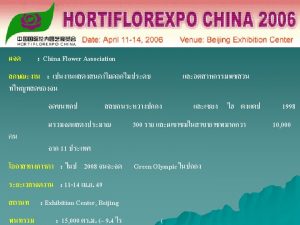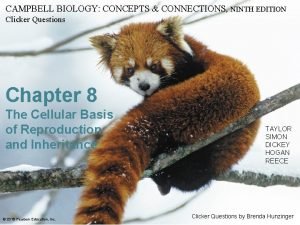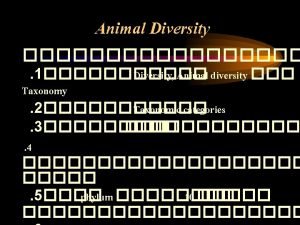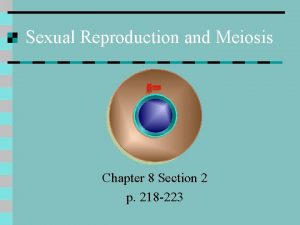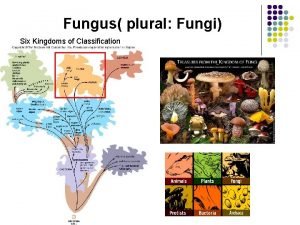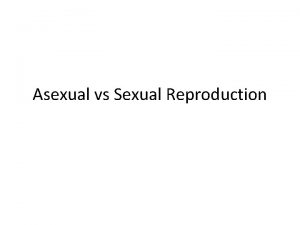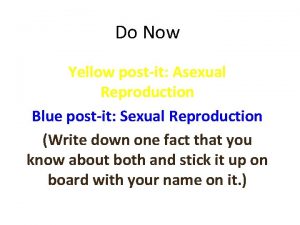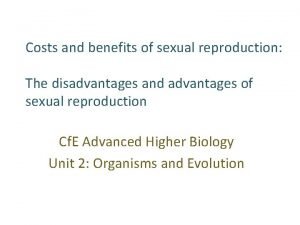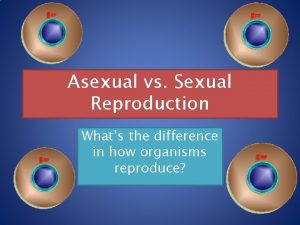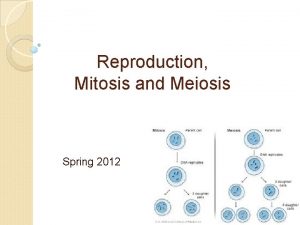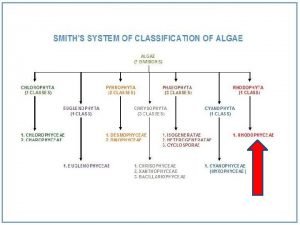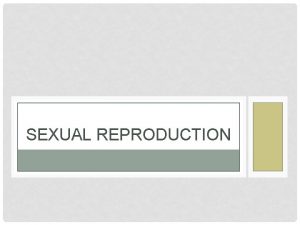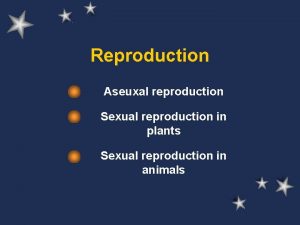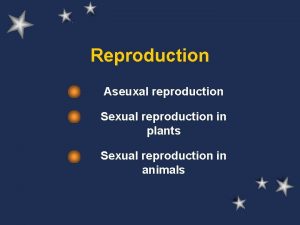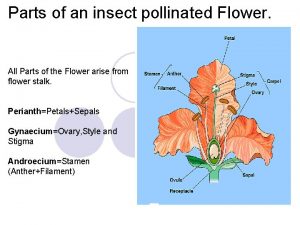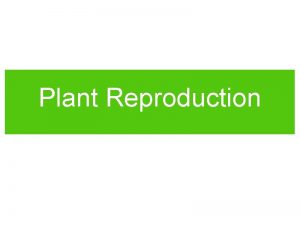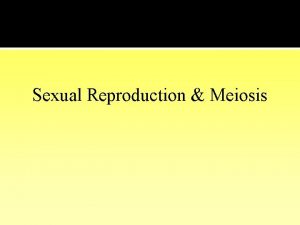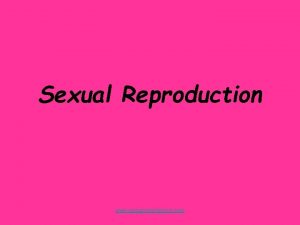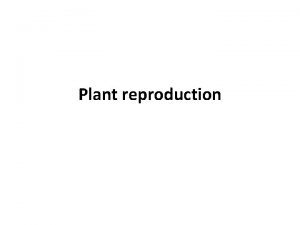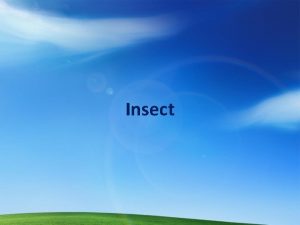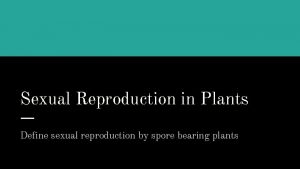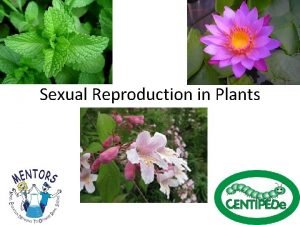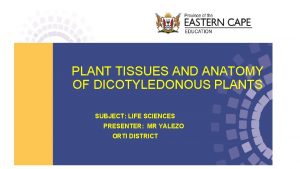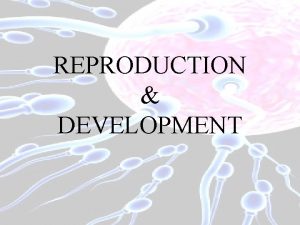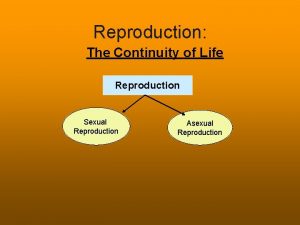Sexual Reproduction in Plants Dicotyledonous Insect pollinated Plants




















- Slides: 20

Sexual Reproduction in Plants Dicotyledonous/ Insect pollinated Plants

Flowers are the reproductive organs of plants Flower Structure Pollination Fertilisation Seed Dispersal Germination Test

Angiosperms have formed many partnerships with animals to move their pollen

Some flowers provide food (nectar) to their pollinators The pollen grain contains the male sex cell (gamete) Nectar which is sugar is usually presented with attractive showy petals and fragrances

Nectar is usually presented together with attractive structures, e. g. , showy petals and fragrances Night Blooming Cirrus


Pollination is plant sex or the transfer of pollen(sperm)from the Click to view the animation anther to the stigma Pollen travels from one flower to a different flower. This promotes variation. Flower Structure Pollination Fertilisation Seed Dispersal Germination Test

Fertilisation occurs when the male gamete fuses with the ovule (the female gamete) Complete the fertilisation section of the worksheet Click to view the animation (you will need to refer to your text book) Flower Structure Pollination Fruit Development Seed Dispersal Germination Test

Pollen is carried between flowers by insects or by wind Pollen has barbs for hooking onto insect fur Attractive nectar and a scent present Anthers positioned to rub pollen onto insects Sticky stigma to collect pollen Flower Structure Pollination Fertilisation Seed Dispersal Germination Test

Flowers will prevent self-pollination by either having stigma above stamen or… • Self-pollination is not desirable as it reduces variation Flower Structure Pollination Fertilisation Seed Dispersal Germination Test

Fertilisation and Fruit Development Flower Structure Pollination Fruit Development Seed Dispersal Germination Test

Plant Sexual Reproduction—Sperm carried in the pollen from the male part of a flower fuses with the egg in the female part of the flower.

Development of the seed and fruit Tissues of the ovary (and sometimes the receptacle) become the fruit

Development of the seed and fruit Fruits aid seed dispersal The ovary wall becomes either a dry or fleshy fruit

Development of the seed and fruit Cotyledons may absorb endosperm throughout their functional lives (e. g. , castor bean) Cotyledons may alternatively function as storage organs that absorb the endosperm prior to a seed’s germination (e. g. , common bean) Fig. 38. 8

Water leaves the seed, it dehydrates and becomes dormant because metabolic reactions stop. The ovary develops to become a fruit. Fleshy wall of the ovary (yes, you are eating an adapted ovary when you crunch into an apple! seed Flower Structure Pollination Fruit Development Seed Dispersal Germination Test

Germination Flower Structure Pollination Fruit Development Seed Dispersal Germination Test

Enzymes are used in seed germination Plumule starch amylase secreted embryo plant ab so rbe d The enzymes break starch down into maltose and then glucose. The glucose is used in respiration to provide energy for growth maltose Radicle This is the first part to grow out of the seed as it needs to absorb more water Flower Structure Pollination Fruit Development Seed Dispersal Germination Test

Changes in dry mass of the germinating seed: Seed loses weight as it uses up starch stores in the cotyledons as the seedling cannot photosynthesise yet Click to listen to an explanation Dry mass/g Weight increases as the seedling can photosynthesise and plant grows Dry mass is the mass of solid matter with all water removed Days Flower Structure Pollination Fruit Development Seed Dispersal Germination Test

Seeds need to be dispersed away from the parent plant in order to reduce competition for space, light, nutrients and water. • Seeds can be dispersed by: • Wind • Water
 Asexual vs sexual venn diagram
Asexual vs sexual venn diagram Asexual reproduction cell division
Asexual reproduction cell division Sexual reproduction and asexual reproduction
Sexual reproduction and asexual reproduction A sexual reproduction in plants
A sexual reproduction in plants Standard grade biology
Standard grade biology Biology
Biology A sexual reproduction
A sexual reproduction Sexual reproduction
Sexual reproduction Conjugated fungi
Conjugated fungi Section 1 meiosis
Section 1 meiosis Sexual or asexual reproduction
Sexual or asexual reproduction Mitosis vs meiosis chart
Mitosis vs meiosis chart Parthenogenesis
Parthenogenesis Benefits of sexual propagation
Benefits of sexual propagation Sexual or asexual reproduction
Sexual or asexual reproduction Sexual reproduction
Sexual reproduction Plants and animals reproduction venn diagram
Plants and animals reproduction venn diagram Chapter 20 sexual reproduction in animals
Chapter 20 sexual reproduction in animals Whats asexual reproduction
Whats asexual reproduction Definition of mitosis
Definition of mitosis Red algae division
Red algae division



